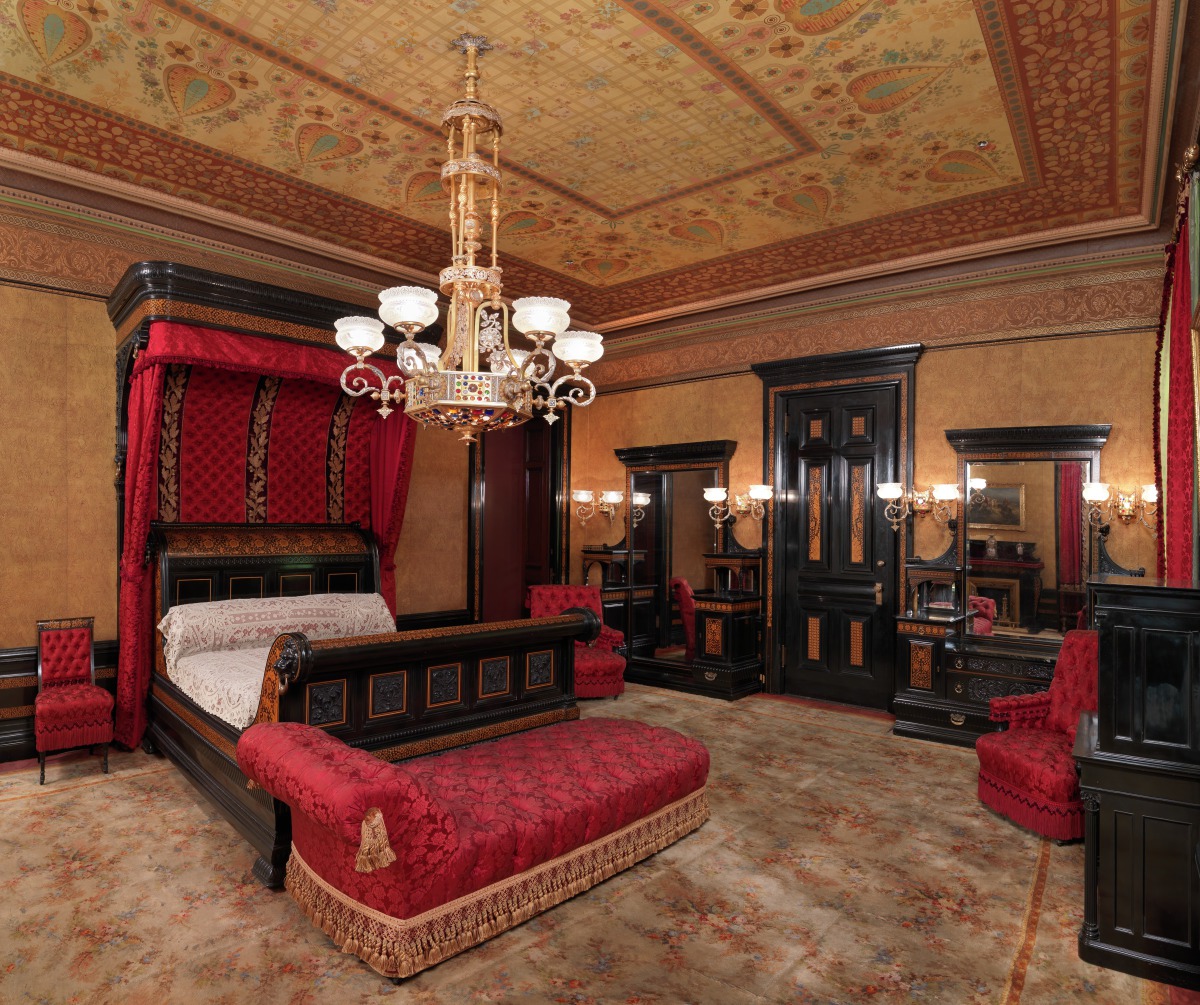
Worsham-Rockefeller Bedroom (Primary Title)
George A. Schastey & Co., American, 1873 - 1897 (Decoration)
Pottier and Stymus Manufacturing Company, American, New York, active ca. 1859 - 1910 (Decoration)
George A. Schastey & Co., American, 1873 - 1897 (Furnishings)
Sypher & Co., active 1869 - 1908 (Furnishings)
This bedroom was originally located in a mid-1860s Italinate brownstone at 4 West Fifty-Fourth Street in New York City. The mansion was purchased in 1877 by Richmond native Arabella Worsham, who, shortly thereafter, commissioned a major New York architect and decorating firm to expand the structure and remodel its interiors. A consummate example of the Anglo-American Aesthetic movement, it expresses what one contemporary reviewer described as an effort to “persuade people to…pursue the paths of true art and taste in furnishing their house.”
Worsham remained in the house until 1884 when – upon marriage to Collis P. Huntington – she sold it to John D. Rockefeller Sr. Following Rockefeller’s death in 1937, three rooms were donated by the family to two New York institutions: the smoking room to the Brooklyn Museum and the bedroom and dressing room to the Museum of the City of New York. In 2008 that museum generously transferred the Worsham-Rockefeller Bedroom to VMFA. The room is the museum’s only period interior.
Two recently discovered archival images document the bedroom around 1884 – the year Arabella Worsham sold the mansion to John D. Rockefeller. The photographs record the original woodwork, painted canvas surfaces, and ebonized furniture currently on view. But they also reveal a different wall covering and carpet. These were produced in 1937 when the room was given by the Rockefeller family to the Museum of the City of New York. At that time, a consultant was hired to smooth the transfer from the Fifty-Fourth Street house. His well-documented role included the selection of new textiles for upholstery and drapery (note the original bedcover that appears in the 1884 photograph) and the design of a new floor covering.
Catharine “Belle” Duvall Yarrington was born in Richmond, Virginia, on June 1, 1850. After her father’s death in 1859, the family lived in a boarding house operated by her mother. When Richmond fell to Union troops in April 1865, the Yarringtons (along with many residents) left the city, moving to New York before 1870.
In addition to its importance as a period interior, the Worsham-Rockefeller Bedroom reveals the role of interior decoration in the cultivation of individual identity. The room documents Arabella Worsham’s transformation from modest circumstances to immense wealth in the fluid social and economic environment of post-Civil War America.
This bedroom features a remarkable suite of ebonized and inlaid furniture that, according to one source, was inspired by a bed belonging to Princess Mathilde Bonaparte Demidoff, niece of Napoleon. However, the room’s overall effect depends on the myriad foreign and historical details in textile, ceramic, metal, and glass that support its highly orchestrated Aesthetic vision.
Such schemes reflected the talents of a new class of professional decorator, who, together with the large-scale manufacturing firm, emerged in the second half of the 19th century. For major commissions, architects were hired to supervise contractors and mediate negotiations between specialists and patrons. Arabella Worsham and Collis P. Huntington (who underwrote the remodeling project) supported numerous firms during the 1870s and 1880s – including George A. Schastey, Herter Brothers, Pottier and Stymus, and Sypher and Company – any or all of which may have collaborated on this room. Attributions are further complicated by the documentary evidence of period photographs (seen here), which reveal later alterations to the original 1881-82 interiors.
[Chair Only] Artistic Furniture of the Gilded Age: George A. Schastey, The Metropolitain Museum of Art, New York, December 15, 2015 - May 1, 2016
Some object records are not complete and do not reflect VMFA's full and current knowledge. VMFA makes routine updates as records are reviewed and enhanced.

